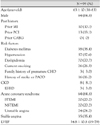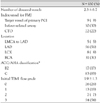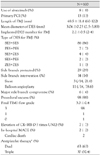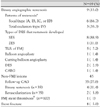1. Kobayashi Y, De Gregorio J, Kobayashi N, et al. Stented segment length as an independent predictor of restenosis. J Am Coll Cardiol. 1999. 34:651–659.
2. Aoki J, Ong AT, Rodriguez Granillo GA, et al. "ull metal jacket" (stented length ≥64 mm) using drug-eluting stents for de novo coronary artery lesions. Am Heart J. 2005. 150:994–999.
3. Kim BK, Oh S, Jeon DW, et al. Clinical outcomes following sirolimus-eluting stent implantation in patients with end-stage renal disease. Korean Circ J. 2006. 36:424–430.
4. Moses JW, Leon MB, Popma JJ, et al. Sirolimus-eluting stents versus standard stents in patients with stenosis in an native coronary artery. N Engl J Med. 2003. 349:1315–1323.
5. Dawkins KD, Grube E, Guagliumi G, et al. Clinical efficacy of polymer-based paclitaxel-eluting stents in the treatment of complex, long coronary artery lesions from a multicenter, randomized trial: support for the use of drug-eluting stents in contemporary clinical practice. Circulation. 2005. 112:3306–3313.
6. Degertekin M, Arampatzis CA, Lemos PA, et al. Very long sirolimus-eluting stent implantation for de novo coronary lesions. Am J Cardiol. 2004. 93:826–829.
7. Park JS, Kim YJ, Shin DG, et al. Clinical and angiographic outcome of sirolimus-eluting stent for the treatment of very long lesions. Korean Circ J. 2006. 36:490–494.
8. Lee CW, Park KH, Kim YH, et al. Clinical and angiographic outcomes after placement of multiple overlapping drug-eluting stents in diffuse coronary lesions. Am J Cardiol. 2006. 98:918–922.
9. Kim W, Jeong MH, Cho JY, et al. The preventive effect on in-stent restenosis of overlapped drug-eluting stents for treating diffuse coronary artery disease. Korean Circ J. 2006. 36:17–23.
10. Tsagalou E, Chieffo A, Iakovou I, et al. Multiple overlapping drug-eluting stents to treat diffuse disease of the left anterior descending coronary artery. J Am Coll Cardiol. 2005. 45:1570–1573.
11. Jaffe R, Strauss BH. Late and very late thrombosis of drug-eluting stent. J Am Coll Cardiol. 2007. 50:119–127.
12. Stene GW, Moses JW, Ellis SG, et al. Safety and efficacy of sirolimus- and paclitaxel-eluting coronary stents. N Engl J Med. 2007. 356:998–1008.
13. Wilson GJ, Polovick JE, Huibregtse BA, Poff BC. Overlapping paclitaxel-eluting stents: long-term effects in a porcine coronary artery model. Cardiovasc Res. 2007. 76:361–372.
14. Finn AV, Nakazawa G, Joner M, et al. Vascular response to drug-eluting stents: importance of delayed healing. Arterioscler Thromb Vasc Biol. 2007. 27:1500–1510.
15. Joner M, Finn AV, Farb A, et al. Pathology of drug-eluting stents in humans: delayed healing and late thrombotic risk. J Am Coll Cardiol. 2006. 48:193–202.
16. Mehran R, Dangas G, Abizaid AS, et al. Angiographic patterns of in-stent restenosis: classification and implications for longterm outcomes. Circulation. 1999. 100:1872–1878.
17. Pinto Slottow TL, Waksman R. Overview of the 2006 Food and Drug Administration Circulatory System Devices Panel meeting on drug-eluting stent thrombosis. Catheter Cardiovasc Interv. 2007. 69:1064–1074.
18. Ryan TJ, Faxon DP, Gunnar RM, et al. Guidelines for percutaneous transluminal coronary angioplasty: a report of the American College of Cardiology/American Heart Association Task Force on Assessment of Diagnostic and Therapeutic Cardiovascular Procedures. Circulation. 1988. 78:486–502.
19. Lee CW, Park SJ. Predictive factors for restenosis after drug-eluting stent implantation. Korean Circ J. 2007. 37:97–102.
20. Serruys PW, Foley DP, Suttorp M, et al. A randomized comparison of the value of additional stenting after optimal balloon angioplasty for long coronary lesions: final results of the additional value of NIR stents for treatment of long coronary lesions (ADVANCE) study. J Am Coll Cardiol. 2002. 39:393–399.
21. Kang WC, Shin EK. Treatment of diffuse long coronary artery disease with overlapping drug-eluting stents is effective? Korean Circ J. 2006. 36:8–10.
22. Das P, Moliterno DJ, Charnigo R, et al. Impact of drug-eluting stents on outcomes of patients with end-stage renal disease undergoing percutaneous coronary revascularization. J Invasive Cardiol. 2006. 18:405–408.
23. Eisenstein EL, Anstrom KJ, Kong DF, et al. Clopidogrel use and long-term clinical outcomes after drug-eluting stent implantation. JAMA. 2007. 297:159–168.
24. Airoldi F, Colombo A, Morici N, et al. Incidence and predictors of drug-eluting stent thrombosis during and after discontinuation of thienopyridine treatment. Circulation. 2007. 116:745–754.
25. Lee MS, Jurewitz D, Argon J, Forrester J, Makkar RR, Kar S. Stent fracture associated with drug-eluting stents: clinical characteristics and implications. Catheter Cardiovasc Interv. 2007. 69:387–394.
26. Aoki J, Nakazawa G, Tanabe K, et al. Incidence and clinical impact of coronary stent fracture after sirolimus-eluting stent implantation. Catheter Cardiovasc Interv. 2007. 69:380–386.










 PDF
PDF ePub
ePub Citation
Citation Print
Print





 XML Download
XML Download